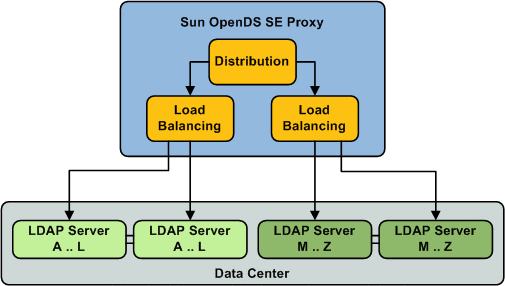| Exit Print View | |
Sun OpenDS Standard Edition 2.2 Deployment Planning Guide |

|
1. Overview of Sun OpenDS Standard Edition
2. Overview of the Directory Server
3. Overview of the Proxy Server
4. Building Blocks of the Proxy Server
5. Example Deployments Using the Directory Server
6. Example Deployments Using the Proxy Server
Deciding Your Proxy Deployment Type
Configuration 1: Simple Load Balancing
Configuration 2: Simple Distribution
Configuration 3: Failover Between Data Centers
Configuration 5: Distribution with Failover Between Data Centers
7. Simple Proxy Deployments Using the Command Line Interface
In a deployment of Sun OpenDS Standard Edition proxy using distribution deployment with load balancing, the data is split into partitions, and the data is replicated on the remote LDAP servers. Requests sent to the Sun OpenDS Standard Edition proxy are first distributed to the partition in which the data is stored, then the request is routed to one of the remote LDAP servers, depending on the load balancing algorithm set. The remote LDAP servers holding the partitioned data are replicated.
As illustrated in Figure 6-4, when the Sun OpenDS Standard Edition proxy receives a requests, it is filtered by the distribution to the correct partition. For example, a request for data Garry would be forwarded to partition 1, to the servers with data from A..L. The load balancer then forwards the request to one of the replicated remote LDAP servers.

The requests are routed to the remote LDAP servers within the data centers based on the load balancing algorithm set. For more information on the different load balancing algorithms, see Load Balancing Using the Proxy.
The advantages of this deployment are the speed of the updates, because of the distribution of data, and high availability of the data.
For more information on the different distribution algorithms, see Data Distribution Using the Proxy.
For more information on the different load balancing algorithms, see Load Balancing Using the Proxy.
For details on deploying this configuration, see Configuring Distribution and Load Balancing.